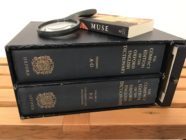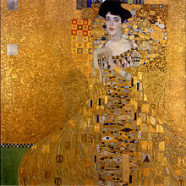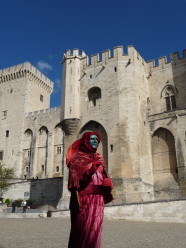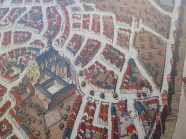Mary Novik's Blog: Mary Novik's blog
March 21, 2020
Beware, dear Countess, of sailors bearing tales from Toulon
To the Vicomtesse de Turenne, palais des Papes, Avignon, as Epiphany approaches, in the year of Our Lord, 1348.
My dear Countess, I write to you as one much changed, whose day is filled with labour and singing the offices faithfully to Our Lord. I have found refuge in this harsh order, with its fierce rule of silence. Here, our hands do the work of our mouths. I have prayed and slept and eaten in my solitary hermitage. I have worked in the fields until I have collapsed in exhaustion. Can you imagine how difficult this silence has been for me, for whom talking is life? … read more
September 29, 2019
Long View of London from Bankside by Wenceslaus Hollar
The most famous view of London is by Wenceslaus Hollar, an engraving titled “Long View of London From Bankside”, which shows the dense tapestry of buildings on either side of the Thames. The view stretches from the Globe Theatre, at the far left (west) to the Tower of London on the far right (east).

On September 28, 2019, The Globe and Mail published an enchanting version of this engraving by Nick Craine, called “A Long View of Shakespeare’s London”. One of the highlights is a lively rendition of the chaos of buildings surrounding old Saint Paul’s Cathedral.
The first Globe Theatre burnt down in June 1613, so Hollar’s map actually shows the second one, built a year later but closed by the Puritans in September 1642. Hollar mislabelled the theatre Bear bayting and labelled the bear-baiting house the Globe. Craine has happily corrected this error, and shows the bear “theatre” as another circular building with a flagpole to the right of the Globe.
In fact, Hollar’s work was printed in 1647, thirty years after Shakespeare died, but fortunately predates the Great Fire of 1666, which destroyed over 70% of the City. The Saint Paul’s Cathedral engraved by Hollar is the pre-fire and spire-less building. (The spire had been destroyed by lightning in 1561.) After the Great Fire, Christopher Wren was tasked with the rebuilding, and the cathedral we know today, with the iconic dome, was finished in 1711.
September 26, 2019
John Donne’s Island and the Brexit Perplex
No one more worthy of being quoted on the Brexit issue than the great English priest and poet, John Donne:
No man is an island, entire of itself; every man is a piece of the continent, a part of the main; if a clod be washed away by the sea, Europe is the less, as well as if a promontory were, as well as if a manor of thy friend’s or of thine own were; any man’s death diminishes me, because I am involved in mankind, and therefore never send to know for whom the bell tolls; it tolls for thee.
This is not from a poem, as many people assume, but from Meditation 17 in his Devotions Upon Emergent Occasions. The full text can be found at the very useful website, Luminarium, along with many other prose works and poems by Donne.

John Donne
September 9, 2019
Muse included in “Ambitious Novels That Offer Original Perspectives on History”
One of the pluses of this millennium is the ease of doing research on-line. When I taught literature, I was sceptical about my students using Wikipedia, but I have made my peace with it and couldn’t live without it now. Other wikis have emerged as finding-tools for information that used to reside in reference books and encylopedias. A few years ago, I decided to give away my own set of dusty encyclopedias. Libraries didn’t want it, nor did second-hand bookshops. I was told to put them into my yellow recycling bag.
However, I still use the Compact Edition of the Oxford English Dictionary (1971) that was invaluable in checking the dates of words when I wrote my novels. Yes, the one with the miniature print and the magnifying glass! I was fastidious in writing Conceit to make sure the word actually existed in the 17th century. It was a little harder with Muse, although I did try.
Incidentally, he word “wiki” does not appear in the 1971 OED. For that, you have to go to the on-line OED, which tells us that the noun “wiki” was first used in 1995 in PC Week in the phrase “wiki-paging utility”. The next use of it was in 2000, so it really did ring in the millennium.

Muse, and the Compact OED, and the magnifying glass
A few days ago, I learned that my novel Muse has been included in Ezvid Wiki in the intriguing category of “Ambitious Novels That Offer Original Perspectives On History”. I love the idea that my work offers an original insight on a period of history, in this case the 14th-century, when the popes resided in Avignon, not Rome. If you are interested, you can see the published wiki here: https://wiki.ezvid.com/m/11-ambitious-novels-that-offer-original-perspectives-on-history-XXsKl2K6vJHYg
January 24, 2019
A Tour of the Maritimes
Ten years ago, in January 2009, I hopped an Airbus in Vancouver wearing new snow boots and carrying a down coat with a hood. I was heading to Saint John to read from my novel Conceit (Doubleday 2007) in the hugely successful Lorenzo Series, organized by poet-in-residence Anne Compton, the tastemaker of the Maritimes. Anne had arranged to bring me in a day early, in case of storms. Her last e-mail warned, “We are in a deep freeze here. You’ll need that new warm coat of yours.”
In Ottawa, the departures monitor showed flights cancelled to Halifax, but not to Saint John. I trudged across the snowy tarmac to board a Dash 8 55-seater, which taxied ominously into a de-icing bay to get sprayed. The 31 minute bumpathon came to a halt in Montreal.
“I wasn’t going to fly into Saint John even if told to,” confided the pilot, as we deplaned, “not in this weather.”
After four hours sleep, I was back at Montréal-Trudeau trying to fly standby. I’d missed my interview on CBC, but was damned if I was going to miss the reading. After two more aborted attempts to get to Saint John, I finagled my way onto a Dash 8 headed (after de-icing) for Fredericton. Once there, I jumped into a taxi and sped south on icy roads to the Fundy city.
Watch out for moose, a sign said. I could barely decipher the driver’s accent – soft, seductive, determined to entertain although I was clutching the door handle and straining my eyes for large mammals ahead. Soon, I had surrendered to the lilting rhythms of tales about the harsh life of the Miramichi and its famous son, novelist David Adams Richards.
I had heard him called the Canadian Faulkner. “What do you think of him?” I asked.
“I went to school with him. His books are all about us, his family and friends. A good man, well liked, still lives here.” (Richards has actually lived in Toronto for the past twelve years.)
When the taxi pulled up at the University of New Brunswick, Saint John, forty minutes late, the coffee and desserts were gone, but eighty people were waiting patiently. Chilled to the bone, I walked straight to the mike, glugged a small bottle of water, and began to read from the Great Fire of London in 1666.
Afterwards, I had my first taste of Atlantic hospitality. The enthusiastic readers lined up to get copies of Conceit signed, then Anne put me into a taxi to the Delta Brunswick, and told me to curl up in bed, watch a bad movie, and order anything I liked from room service. My tray arrived with a glass of pinot gris, poached Atlantic salmon, and a large thermos of hot chocolate.
The next morning, I caught a bus back to Fredericton, which was a balmy minus10°. Waiting to escort me to lunch was Ross Leckie, creative writing chair at UNB Fredericton. Listening to Ross talk about writers he admired, I picked up a purity of motive, a cultivation of language for its own sake, refreshing after the Vancouver writing scene. Fredericton is a city of poets, a culture going back to poet-in-residence Alden Nowlan and to the Confederation poets. Poets aren’t marginalized here as they are in the rest of Canada: they are the centre. Today, Ross’s talented students meet in the ice house where the ice-house gang, a group of writers that included David Adams Richards, workshopped in the early seventies.
Mark Jarman, the fiction half of the creative writing team, took me to dinner where we were joined by novelist-in-residence, the Irish writer Gerard Beirne. They ordered pints of beer and we dove headlong into another literary conversation. That night, I was asked to read long passages, something people squirm through in large cities, yet the audience was attentive. Afterwards, the faculty took me to Alden Nowlan’s house, now a clubhouse for grad students, where I was handed a pint of ale and taken round to look at the memorabilia by Brian Bartlett.
A 36-seat plane delivered me to Halifax the next morning. No reception committee was there to meet me. Big city, I thought, setting out to explore on my own. Lonely and hungry by late afternoon, sure no dinner would be in the offing, I treated myself to a giant steak and garlic mashed potatoes. Back at the inn, my phone rang. It was my host, Alexander MacLeod, arranging to take me to the reading. Young, hip, intelligent – it was too much to expect old-world gallantry. But maybe not – he dashed ahead to his car to open the passenger door for me.[image error]
The reading took place in St. Mary’s University Art Gallery, a fantastic backdrop, and Alexander’s introduction was superb. When it was over, he and fellow faculty member Stephanie Morley insisted on taking me out for dinner. Alexander regaled us with insider tales about local writers. Romans-à-clef, the pastoral versus the gritty, new “comers” versus the old guard, defections to Upper Canada, writing clans and outsiders, scandals and feuds—this was juicy stuff. The pints of beer were being drained and I felt, for a moment, like an honorary member of the Atlantic tribe.
I gulped down more Shiraz. “Why am I the only one who orders wine?”
“Too snooty,” they told me, grinning. “People here don’t have money for wine. It shows you’re from away, not from here.”
In my head, names of fiction writers were swirling: Wayne Johnston, Ann-Marie MacDonald, Bernice Morgan, Lynn Coady, Michael Winter, Lisa Moore, Joan Clark, Michael Crummey, Ami McKay, Donna Morrissey, Don Hannah, Mark Jarman, Edward Riche, and Alexander himself, son of Alistair MacLeod of Cape Breton Island. Add in the poets Anne Compton, George Elliott Clarke, Brian Bartlett, Anne Simpson, and Ross Leckie’s new ice-house gang. And that’s just the tip of the eastern iceberg. It hit me that the Atlantic is experiencing a boom surpassing anything across the country. A renaissance, if that isn’t too snooty a term for it.
Driving me back to my inn, Alexander detoured to the citadel to show me Halifax at night. Although I’d missed Saint John’s reversing falls, I would journey back to the other ocean buoyed up by Maritimes hospitality and the rising tide of Atlantic literature.
First published at the Random House Booklounge website
February 4, 2016
Valentine’s Day and the San Miguel Writers’ Conference
February is shaping up to be an enjoyable month. Éditions Hurtubise is hosting a Valentine’s Day promotion for the French e-book/pdf of Muse for the very attractive price of $9.00. As they say, «Pour la Saint-Valentin, offrez-vous une histoire d’amour!»
Guess where I’m going to be spending Valentine’s Day? In Mexico!

San Miguel Writers’ Conference
In a few days, I’ll escape rainy Vancouver on a jet to León, then board a shuttle to San Miguel de Allende, a town with a fantastic reputation. I’ve been hearing good things about it from friends and fellow writers for years. Yes, it’s full of expats, but I’ve read that whereas Canadians and Americans move to Florida to retire, they re-locate in San Miguel to re-invent themselves. It’s bursting with talented people—writers, artists, musicians, weavers, craftsmen—as well as interesting architecture, restaurants, coffee shops, and natural sights. But best of all, every February brings the San Miguel International Writers’ Conference. With about 350 conference-goers, the festival is small enough to be very friendly, yet large enough to attract international authors, who mingle with the readers and eager emerging writers. I’ve been invited to participate in several events this year and I’m really looking forward to it. Since I’ve never been to Mexico and don’t speak Spanish, I’m counting on Duolingo!
The post Valentine’s Day and the San Miguel Writers’ Conference appeared first on Mary Novik, author of Conceit and Muse.
September 6, 2015
Another Film About Art Repatriation Misfires
 I’ve just seen another film on the popular subject of art repatriation, along the lines of the Hollywood “comedy-drama” Monuments Men. The latest is the disappointing Woman in Gold, starring a horribly miscast Helen Mirren, about the fate of the Klimt painting of Adele Bloch-Bauer. This made me think about the superb Edmund de Waal book, The Hare with Amber Eyes, which no doubt will soon be made into a shallow film. De Waal’s great-grandmother, Emmy von Ephrussi, lived in the magnificent Palais Ephrussi on the Ringstraasse in Vienna, where the Bloch-Bauers also lived. In 1938, both the Ephrussis and the Bloch-Bauers were crushed by the Nazis in the Anschluss annexation and their businesses, palaces, and art (including the “Woman in Gold” and the “hare with the amber eyes”), were seized. Another branch of the Ephrussi family lived on the posh rue de Monceau in Paris, alongside other great Jewish families, including the Rothschilds and the Camondos. When Moise de Camondo’s son Nissim died flying for France in the first world war, he bequeathed his “hôtel”, with its magnificent furnishings and art, to be kept exactly as they were as a tribute to his son, to the Musée des Arts Décoratifs in Paris. In spite of this, Paris did not protect his daughter and her children, who were sent to Auschwitz to perish. If you visit Paris, you must visit their house, the Musée de Camondo on the rue de Monceau, which is one of the most impressive small museums in Paris. In a small room upstairs in this palace, there is a history in film, photographs, and writings of the people who once lived in it. No doubt, someone will soon be writing a book and making a superficial film about them.
I’ve just seen another film on the popular subject of art repatriation, along the lines of the Hollywood “comedy-drama” Monuments Men. The latest is the disappointing Woman in Gold, starring a horribly miscast Helen Mirren, about the fate of the Klimt painting of Adele Bloch-Bauer. This made me think about the superb Edmund de Waal book, The Hare with Amber Eyes, which no doubt will soon be made into a shallow film. De Waal’s great-grandmother, Emmy von Ephrussi, lived in the magnificent Palais Ephrussi on the Ringstraasse in Vienna, where the Bloch-Bauers also lived. In 1938, both the Ephrussis and the Bloch-Bauers were crushed by the Nazis in the Anschluss annexation and their businesses, palaces, and art (including the “Woman in Gold” and the “hare with the amber eyes”), were seized. Another branch of the Ephrussi family lived on the posh rue de Monceau in Paris, alongside other great Jewish families, including the Rothschilds and the Camondos. When Moise de Camondo’s son Nissim died flying for France in the first world war, he bequeathed his “hôtel”, with its magnificent furnishings and art, to be kept exactly as they were as a tribute to his son, to the Musée des Arts Décoratifs in Paris. In spite of this, Paris did not protect his daughter and her children, who were sent to Auschwitz to perish. If you visit Paris, you must visit their house, the Musée de Camondo on the rue de Monceau, which is one of the most impressive small museums in Paris. In a small room upstairs in this palace, there is a history in film, photographs, and writings of the people who once lived in it. No doubt, someone will soon be writing a book and making a superficial film about them.
The post Another Film About Art Repatriation Misfires appeared first on Mary Novik, author of Conceit and Muse.
August 10, 2015
36 Hours in Arles and Avignon

Avignon’s Carousel
The New York Times has just featured Arles and Avignon in its spectacular “36 Hours” series, which I have been following for several years. How exciting to see Avignon, the setting for my novel Muse, featured! “Just 20 minutes apart by train, the Roman-era town of Arles and the medieval walled city of Avignon enfold a dense mix of architectural beauty, world-class art, sun-soaked Provençal gastronomy and Unesco World Heritage sites.”

Palais des papes, Avignon
As I read the article, I was transported back into trips to Avignon, which I visited five times doing research. Since my last trip, exciting restaurants have opened and museums have expanded and added to their collections. Of course, the highlight is still the popes’ magnificent palace. “It’s good to be pope. If you happened to be one of those who lived in Avignon during the religious turmoil of the 14th century (when the papacy abandoned Rome), you would have presided over an immense Gothic palace filled with soaring banquet halls, huge vaulted chapels and lush gardens populated with peacocks, camels and other exotic fauna. These areas and more are viewable in the Palais des Papes, whose smaller rooms are equally impressive. The papal bedroom is painted with cosmic swirls of vegetative motifs, while the study is covered by mystical frescoes of a noctural stag hunt in a forest inhabited by a dragon and unicorn.” Is it any wonder that, after viewing this superb bedroom, I used it as the backdrop to a pivotal scene in Muse?

Avignon
A new feature of the New York Times’ “36 Hours” series is an interactive map, with the stops on the itinerary pinned to it. You can follow the recommended route easily on the map, and enjoy the same sights, cafes, bars, and shops yourself. The on-line version also recommends a number of hotels. If you enjoy the article, you might enjoy my YouTube video of the Pope’s palace as well.
The post 36 Hours in Arles and Avignon appeared first on Mary Novik, author of Conceit and Muse.
May 30, 2015
Re-enactment of John Donne’s Gunpowder Sermon, 1622
On November 5, 1622, the Dean of Saint Paul’s Cathedral, John Donne (the main subject of my novel, Conceit), preached a sermon in St Paul’s yard for Gunpowder Day. A brilliant digital re-creation of this sermon, which includes elaborate models, diagrams, videos, and acoustic files, gives us the amazing opportunity to be part of the large crowd listening to John Donne on this day. “Evidence from contemporary accounts suggest that their early modern counterparts were more like theatrical performances, interactive conversations between preacher and congregation, events staged for their entertainment value . . . in which both preacher and congregation had active roles to play.” Of all the riches on this amazing website, this video fly-past of the churchyard, crowd, and buildings is perhaps the most impressive.
The post Re-enactment of John Donne’s Gunpowder Sermon, 1622 appeared first on Mary Novik, author of Conceit and Muse.
May 9, 2015
London Before the Great Fire of 1666
What did London look like before the Great Fire of 1666 that destroyed the old Saint Paul’s Cathedral? Six students from De Montfort University in Leicester “have turned a historic map into a realistic and detailed 3D animation of Tudor London,” says The Telegraph. “The video shows the area around Pudding Lane in the City of London before the Great Fire of 1666. Some of the buildings are hypothetical, but all streets are based on original maps of the area. The animation has won the top prize in a competition to produce a 3D animation of a real historic setting.” The “haze effect lying over the city is brilliant,” says Tom Harper, panel judge and curator at the British Library. “Great attention has been given to key features of London, complete with glittering window casements and other atmospheric cues.”
The post London Before the Great Fire of 1666 appeared first on Mary Novik, author of Conceit and Muse.
Mary Novik's blog
- Mary Novik's profile
- 92 followers



